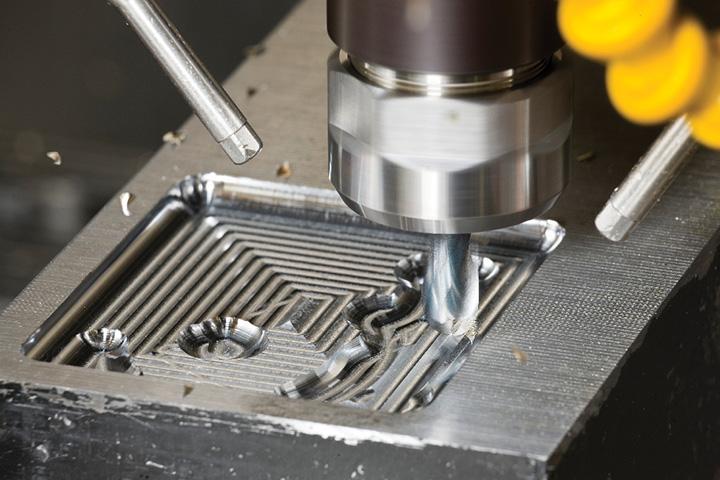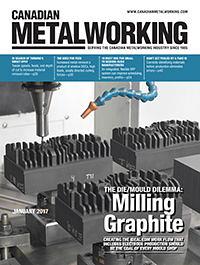- FMA
- The Fabricator
- FABTECH
- Canadian Metalworking
The Need for Feed
Increased metal removal a product of shallow DOCs, high feeds, axially directed cutting forces
- By Canadian Metalworking
- January 30, 2017
- Article
- Cutting Tools

High-feed milling improves metal removal rates given the correct cutting parameters and tooling choice. Photo courtesy of Seco Tools.
High-feed milling combines shallow axial depths of cut with higher-than-normal table feed rates to increase metal removal. Because the cutting forces are directed axially – up into the spindle – the process also is more stable.
High-feed milling essentially is a roughing method developed to achieve higher metal removal rates to increase productivity and decrease machining time for each workpiece, regardless of material.
Canadian Metalworking recently asked Seco Product Manager for Indexable Milling Tim Aydt and Product Manager for Solid-carbide End Mills Jay Ball, as well as Walter USA Product Manager for Milling Luke Pollock, to weigh in with their opinions on high-feed milling. Here is what they had to say.
CM: How does high-feed milling differ from traditional milling?
Pollock: High-feed milling is a method of removing material based on taking light depths of cut, but using accelerated feed rates to maintain, or even improve, the overall volume of material removal.
Aydt and Ball: The process combines a shallow depth of cut with a large cutting radius or small lead angle to ensure that the cutting forces are directed toward the machine spindle in the axial direction. Axially directed cutting forces result in greater tool stability, which allows for greatly increased feed rates, sometimes up to 10 times the normal rate.
CM: Are the tools different?
Pollock: Sometimes. Often the insert is more of a standard milling insert, like an SDMT, and it’s the way that it is spotted in the tool that allows high-feed milling. But there are special inserts that are designed for high-feed milling. These have the low lead angle built into the insert.
Sometimes the inserts have a positive basic shape, which allows them to cut more freely and produce less horsepower while in the cut.
These special inserts can also have a negative basic shape. They are stronger and wear less (compared to the positive basic shaped insert), but they will also produce more heat and draw more horsepower, so they may not always be the best choice.
Negative basic shaped inserts also will have double the number of indexes over a comparable positive basic shaped insert.
CM: How does entry angle affect the cut?
Aydt and Ball: High-feed milling has more to do with the entry angle of the insert leading into the material, the shape of the insert, and the depth of cut [than it does about tool design]. The lighter the depth, the more aggressive we can set the feed.
Pollock: Tools specifically designed for high-feed milling have a very low lead angle built into the cutter. Sometimes this is done with an insert having a straight cutting edge positioned with around a 15-degree lead [and] sometimes the lead angle is built into the shape of the insert to create a very low lead angle.
The low lead angle creates an axial chip thinning effect. Axial chip thinning occurs when the physical thickness of the chip is less than the advance per tooth programmed into the machine. The feed rate per tooth needs to be increased so the desired chip thickness can be generated.
CM: How do coatings aid the milling process?
Aydt and Ball: Coatings are designed to protect the base insert material and are steered toward specific material groups. Material groups that require higher operating temperatures generally are CVD-coated. Materials that require lower cutting temperatures, such as titanium, often have a PVD coating.
Pollock: Coating technology is constantly improving to increase tool life. But for every property that is improved to combat a specific failure mode, another property may be hurt.
For example, if we put elements into the coating to protect against heat, there is a limit as to how much we can add before the coating becomes thick and brittle. Finding the range of what is possible is always the challenge.
The same is true for the surface of the coating. We are always striving for a smooth top layer to prevent the material from sticking to the face of the insert and reducing the amount of heat generated as the chip slides across the rake face of the insert.
For a supersmooth insert face, a thinner coating allows us to achieve this. But if the coating is too thin, it may not offer the level of wear resistance needed. This all leads us to developing different grades for different materials and dialing in the specific makeup of the insert to combat specific failure modes.
CM: Is there a difference in coatings for high-feed milling?
Pollock: High-feed milling [as a technique] doesn’t get any special considerations in grade development and selection over standard milling applications. A grade suitable for the material needs to be selected.
CM: What is the best way to deploy coolant in high-feed milling?
Pollock: In many milling applications, the most important function of the coolant is to flush the chips away from the cutting zone. Since high-feed milling is producing a lot of chips in a short amount of time, maximum flushing of the chips should be the goal. This means using higher pressure and more volume.
CM: How important is tool stability?
Aydt and Ball: Stability is always important; however, since the high-feed method utilizes low depths of cut, cutting forces are more axial in nature, so, vibration is minimized to some extent.
Pollock: Having a stable tool or a stable process is always of vital importance.
If the setup is somewhat short of perfect, this is where high-feed milling can be an advantage. The low lead angle used in the tools to develop a high amount of axial chip thinning has the added benefit of directing the majority of the cutting forces straight back up through the spindle.
So, while a 90-degree shoulder mill has 100 per cent of the cutting forces be seen as a side load to the spindle (trying to push the tool over), a high-feed mill has only 25 per cent of the cutting forces seen as a side load. [The rest] of the cutting forces will be directly into the spindle.
The machine can handle these forces much more easily and can therefore handle more of them without ill effects to the cutting operation like chatter or overcutting. This can also allow longer overhangs and extensions to be used caused by lower side loads.
CM: What role does stable workholding play?
Pollock: Stable workholding is as important as a stable tool assembly. The situation is not quite so critical when using a high-feed mill compared to a more traditional 90-degree shoulder mill because of the cutting forces.
As mentioned earlier, with high-feed milling, 75 per cent of the cutting forces are directed straight up into the spindle, which means that less of the cutting forces are pushing sideways on the part, trying to move it off the fixture or push against the side wall.
If the workholding is short of perfect, another machining technique that could be used is to plunge-cut with a high-feed mill. This method removes material by cutting only when feeding in the Z direction. This makes for a very strong and rigid toolholding assembly because the machine itself is supporting the majority of the cutting forces. It also exerts almost no side load on the part. All of the cutting forces are pushing the part into the fixture or the table of the machine.
Seco Tools, 248-528-5200, www.secotools.com
Walter USA, 800-945-5554, www.walter-tools.com
About the Author
Related Companies
subscribe now


Keep up to date with the latest news, events, and technology for all things metal from our pair of monthly magazines written specifically for Canadian manufacturers!
Start Your Free Subscription- Trending Articles
Automating additive manufacturing

CTMA launches another round of Career-Ready program

Collet chuck provides accuracy in small diameter cutting

Sandvik Coromant hosts workforce development event empowering young women in manufacturing

GF Machining Solutions names managing director and head of market region North and Central Americas

- Industry Events
MME Winnipeg
- April 30, 2024
- Winnipeg, ON Canada
CTMA Economic Uncertainty: Helping You Navigate Windsor Seminar
- April 30, 2024
- Windsor, ON Canada
CTMA Economic Uncertainty: Helping You Navigate Kitchener Seminar
- May 2, 2024
- Kitchener, ON Canada
Automate 2024
- May 6 - 9, 2024
- Chicago, IL
ANCA Open House
- May 7 - 8, 2024
- Wixom, MI















